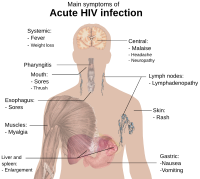
Photo from wikipedia
Background: Limited data exist on early predictive clinical symptoms or combinations of symptoms that could be included in the case definition of coronavirus disease 2019 (COVID-19), particularly for mild-to-moderate disease… Click to show full abstract
Background: Limited data exist on early predictive clinical symptoms or combinations of symptoms that could be included in the case definition of coronavirus disease 2019 (COVID-19), particularly for mild-to-moderate disease in an outpatient setting. Methods: A cohort study of individuals presenting with clinical symptoms to one of the largest dedicated networks of COVID-19 test centers in Geneva, Switzerland, between March 2 and April 23, 2020. Individuals completed a symptom questionnaire, received a nurse-led check-up, and nasopharyngeal swabs were obtained. An analysis of clinical features predicting the positivity and negativity of the SARS-CoV-2 RT-PCR test was performed to determine the relationship between symptoms and their combinations. Results: Of 3,248 patients included (mean age, 42.2 years; 1,504 [46.3%] male), 713 (22%) had a positive RT-PCR; 1,351 (41.6%) consulted within 3 days of symptom onset. The strongest predictor of a positive SARS-CoV-2 RT-PCR was anosmia, particularly in early disease, followed by fever, myalgia, and cough. Symptoms predictive of a negative test were breathing difficulties, abdominal symptoms, thoracic pain and runny nose. Three distinct networks of symptoms were identified, but did not occur together: respiratory symptoms; systemic symptoms related to fever; and other systemic symptoms related to anosmia. Conclusions: Symptoms and networks of symptoms associated with a positive/negative SARS-CoV-2 RT-PCR are emerging and may help to guide targeted testing. Identification of early COVID-19-related symptoms alone or in combination can contribute to establish a clinical case definition and provide a basis for clinicians and public health authorities to distinguish it from other respiratory viruses early in the course of the disease, particularly in the outpatient setting.
Journal Title: Frontiers in Medicine
Year Published: 2021
Link to full text (if available)
Share on Social Media: Sign Up to like & get
recommendations!